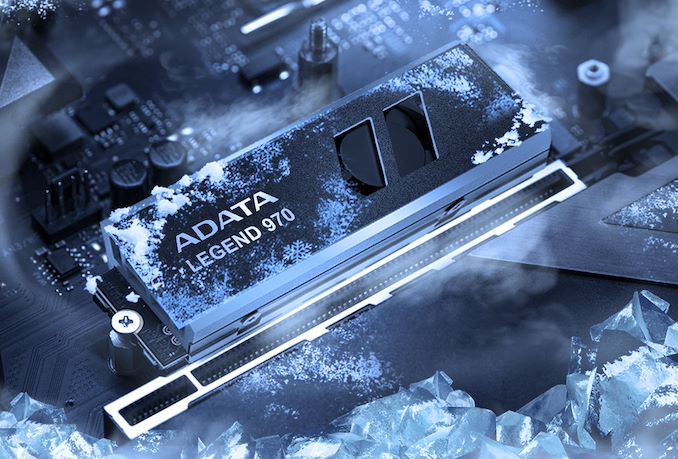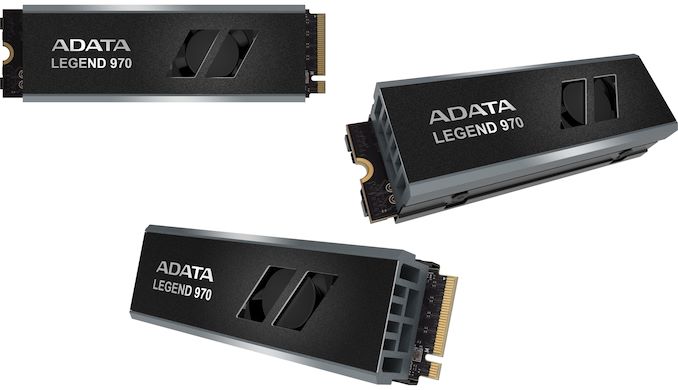Adata Reveals Its First PCIe Gen5 SSD: Legend 970
by Anton Shilov on July 6, 2023 7:30 PM EST
Adata has introduced its first PCIe 5.0 SSD, the Legend 970. A Phison E26-based design, the Legend 970 pairs Phison's high-end controller with a sophisticated active cooling system that promises predictable performance even under high loads. The Legend 970 SSD is aimed at high-performance desktops that can take advantage of fast storage devices.
Adata's Legend 970 drives come in 1 TB and 2 TB capacities and are rated for an up to 10,000 MB/s sequential read/write speed as well as a 1.4 million random read/write IOPS, performance levels in line with those of many current-generation enterprise-grade SSDs. The drives fully support all modern SSD technologies that one comes to expect from a contemporary drive, including SLC cache, Low Density Parity Check Code (LDPC) error correction, and AES 256-bit high-level encryption.
Like other PCIe Gen 5 SSDs available now, the Legend 970 product uses Phison's PS5026-E26 controller. As for memory, the drives use Micron's 232-layer TLC NAND with a 1600 MT/s interface.
One of the key selling points of Adata's Legend 970 is its cooling system, which although a bit on the bulky side of matters, is designed to be robust enough to keep the drive from thermal throttling even under high, sustained loads. Though at 80.6×24.2×17.9mm in size, the resulting SSD is decided a desktop part – and even then the drive will need a fair bit of clearance to fit.
Adata's iniital Legend 970 SSD will eventually be joined by at least one other PCIe 5.0 SSD as well. The company's XPG division is working on their NeonStorm SSD, which uses a self-contained liquid cooling system, and is rated for read speeds of up to 14GB/second (thanks to TLC NAND with a 2400 MT/s interface).
Adata's Legend 970 drives will come with a five-year global warranty. The company hasn't published any pricing information, though we'd expect the drives to be more or less in line with other first-generation PCIe Gen5 SSDs.
Source: Adata











26 Comments
View All Comments
brucethemoose - Sunday, July 9, 2023 - link
> CPUs aren't going to hit their maximum power limits very often. Not in gaming, only in productivity tasks that can use all the cores.Maybe they don't max out, but they boost to extremely aggressive, inefficient voltages/clocks at the drop of a hat.
Modern GPUs are like this too, they run at very high clocks in light loads because they just keep on boosting until they hit the TDP cap.
Older hardware was not this aggressive. Maybe its just a coincidence because the clocking/power schemes were more "primitive," but it still seems incredibly wasteful, and is a hidden cost for whoever is paying the power bill.
nandnandnand - Sunday, July 9, 2023 - link
So a CPU momentarily boosts, to load a webpage or something, but whatever it is trying to get done gets done faster. Less or the same energy is used in the end. I recall Intel and/or AMD boasting about improvements that allow cores to ramp up and go back to idle faster, like 1ms instead of 20ms or whatever it was. Aggressive is not necessarily inefficient.With many games and applications, only a single core is going to see heavy sustained loads. I don't think you see 1 core using more than 20-30 Watts typically. I know some AnandTech reviews have looked at that.
Personally, I'm ready to ditch discrete GPUs. I won't complain about a 65 Watt APU's boosting behavior, and I'd be willing to get a "mega APU" that could use even more power (e.g. 105-170 Watt TDP).
Samus - Monday, July 10, 2023 - link
I get what you mean about boosting to get a task done quicker, potentially saving power. But this has proved untrue. Anandtech did a scaling study of Intel and AMD CPU’s that shows modest performance penalty with massive reduction in power consumption when reducing voltage and clock speed/boost ratios. It turns out the peak performance:power consumption was 65-90w peak for Intel and 45-65w for AMD.Neither company sells a mainstream desktop product with these stock figures. And it’s explains why the laptop CPU’s are so close to their desktop parts. They are pissing away power on desktop, twice the consumption in some cases, to get 10% more performance.
And the analogy is use to explain how this is not momentary power consumption but actually hitting your power bill harder than you think is the same as the auto market. Cars and trucks now have insane stock performance figures. Meanwhile, fuel economy has been almost stagnant for decades in most segments. Yes some of it has to do with weight but most of it has to do with people gunning it more often as the confidence behind the wheel is increased. Programs are the same way and will run your system inefficiently to get that extra boost it wants.
TheinsanegamerN - Tuesday, July 11, 2023 - link
Such a mega APU would be worthless due to bandwidth limitations.back2future - Saturday, July 8, 2023 - link
Comparing sequential read/write and random read/write, sequential r/w would be optimized for ~7.3kB/s and power requirement for full speed 10GB/s is ~1.5-2W/GB bandwidth(?), while Sata (600MB/s) SSD's ~5-8W/GB bandwidth(?), but lower top power requirements (3-5W).Are idling power requirements similar on Pcie5 and Sata SSDs?
Vink - Tuesday, July 11, 2023 - link
It looks excellent, it has the best technology, with the best active not passive cooling, I would like to put it in a $100 ATX case with removable dust filters including the front (not only mesh) and on a motherboard Z with PCIe 5.0 & DDR5 and a K CPU ... so I'm looking forward to the price and technical details.